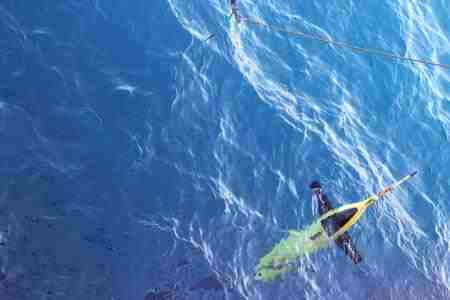Robotic "Dolphin" Drones Find Clues About Antarctic Ice Melt
| Ana Verayo | | Nov 12, 2014 03:49 AM EST |
(Photo : Andrew Thompson/Caltech) A Caltech Seaglider being released into the Weddell Sea off the coast of the Antarctic Peninsula.
Robotic "dolphins" are now being used to gather more data and information about rising global temperatures in the Antarctic and its effect on the planet.
These dolphins are called subsea drones or seagliders. They don't have motors but instead operate via pumping water in and out of nozzles.
Like Us on Facebook
Two studies released this year detail evidence showing the melting West Antarctic ice sheet located on the southern part of the continent could now be irreversible. Sea levels will rise up to 10 feet when this massive amount of ice melts into liquid water.
Since ocean waters are experience rising temperatures especially near the Antarctic coast, this event is melting of the undersides of the ice shelves, rendering them fragile and prone to break apart. This fracturing will ultimately reduce the ice cover in this region.
Another factor that contributes to the disappearance of the ice sheets are ocean eddies or underwater storms caused by warmer mid-ocean depths in the areas above or below them. It's still unclear to researchers what causes these warmer ocean temperatures but man-made climate change and global warming is a possibility researchers are willing to explore and understand more.
Studying these ocean eddies will lead to a greater understanding of global warming and why these changes are happening, according to oceanographer Andrew Thompson from CalTech.
As the robot dolphins dive for more than a mile under the Weddell Sea, they are controlled by scientists in Norwich, England. Each of the machines measures six feet.
These autnomous vehicles send data to home base when they reach the surface. This important data includes water temperatures and density, as well as water salinity.
Salt water freezes at a lower temperature as opposed to fresh water. Since these are warmer waters, it's less likely ice will form in these regions.
These gliders help save costs compared to manned ocean and climate observing systems and are more efficient, according to CalTech researchers.
This study was published in the journal, Nature Geoscience.
TagsRobotic "Dolphin" Drones Find Clues About Antarctic Ice Melt, antarctic ice melt, robotic dolphins, subsea drones, ocean gliders, global warming, caltech, robot dolphins drones antarctic ice melt
©2015 Chinatopix All rights reserved. Do not reproduce without permission
EDITOR'S PICKS
-

Did the Trump administration just announce plans for a trade war with ‘hostile’ China and Russia?
-

US Senate passes Taiwan travel bill slammed by China
-

As Yan Sihong’s family grieves, here are other Chinese students who went missing abroad. Some have never been found
-

Beijing blasts Western critics who ‘smear China’ with the term sharp power
-

China Envoy Seeks to Defuse Tensions With U.S. as a Trade War Brews
-

Singapore's Deputy PM Provides Bitcoin Vote of Confidence Amid China's Blanket Bans
-

China warns investors over risks in overseas virtual currency trading
-

Chinese government most trustworthy: survey
-

Kashima Antlers On Course For Back-To-Back Titles
MOST POPULAR
LATEST NEWS
Zhou Yongkang: China's Former Security Chief Sentenced to Life in Prison

China's former Chief of the Ministry of Public Security, Zhou Yongkang, has been given a life sentence after he was found guilty of abusing his office, bribery and deliberately ... Full Article
TRENDING STORY

China Pork Prices Expected to Stabilize As The Supplies Recover

Elephone P9000 Smartphone is now on Sale on Amazon India

There's a Big Chance Cliffhangers Won't Still Be Resolved When Grey's Anatomy Season 13 Returns

Supreme Court Ruled on Samsung vs Apple Dispute for Patent Infringement

Microsoft Surface Pro 5 Rumors and Release Date: What is the Latest?










